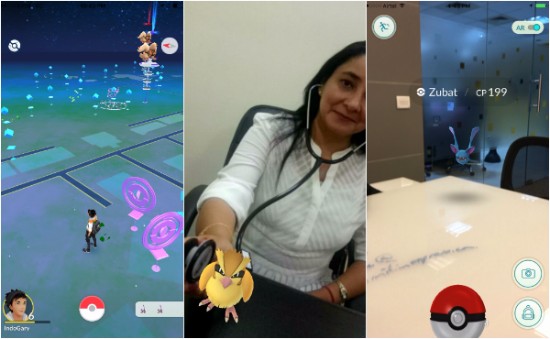
Our internal analysis on Pokémon GO, or PoGo, estimates that it will cross a whopping 100 million users in its first month, and is generating $10,000 every minute in revenue from users. It’s been called a “monster mobile hit” by the BBC, a potential “cultural zeitgeist” by TechCrunch, and a consumer of everything, “including politics” by CNN. PokéStories are at once ubiquitous, concerning, hilarious and uplifting. No sphere of modern society has been untouched including: business, politics, medicine and even crime.
In the wake of this digital tsunami, Augmented Reality (AR), a long awaited promise that was in danger of being leapfrogged by its cooler cousin virtual reality(VR), has been given a new lease on life. PokémonGO is an augmented reality game; and its success augurs the onset of an independent, mass market and thriving industry that remain unestablished by Google glass and its brethren.
What is Augmented Reality
Not to be confused with virtual reality, augmented reality is the superposition of computer-generated images (CGI), video or sound onto a representation of real world images, video or even data. That means cute Pokémon that appear in your camera view; but also movies like Roger Rabbit or even just display projections like in a Tesla. As such, augmented reality we’ve seen AR for decades, in places like the Weather Channel.

Stills from the movie: Who Framed Roger Rabbit(1988)
Augmented Reality in Pokémon
In PoGo, AR is used in 3 ways. First, a player’s avatar walks on an actual Google Maps projection of the world. The device’s GPS allows the game to know exactly where the user is. To check in to a Pokéstop or fight at a Pokégym, the player has to move to that location.

Another use of AR occurs once a player has found a Pokemon, tapping it launches the device’s camera where the cartoon Pokemon is hanging out somewhere in the surroundings. Players have to turn the camera, until they find it, and then flick a Pokeball at it to capture.
Third, while in the capture mode, you can actually take a picture from the camera and the Pokemon will appear on the image taken. So if you’re good, or lucky, you can get some pretty cool shots of Pokemon that seem to interact with real life. This makes for some amusing shots that can create social media gold.
How advance is Augmented Reality in PoGo
AR in PoGo is relatively unevolved. This is because the “augmented” element does not interact at all with the “reality” element. A Pokémon on screen is agnostic to whether it is in a water body, on a table or on someone’s lap. It is just superimposed at a certain position in 3D space; the game relies on the gyroscope of the device to determine if the Pokémon is viewable in the frame. Still, that combined with the GPS location makes for real teamplay amongst Pokémon Trainers as they help each other find and “catch ‘em all”. Even with the basic level of augmented reality, PoGo has shown that the interaction of games with the real-world can profoundly affect human behaviour.
See also: Pokémon GO - The game, the sport, the therapy?
What’s next for Augmented Reality
So now that relatively simple AR is proving its merits, what is advanced AR and what can it do? There are two additional features of AR that go beyond the PoGo experience.
First, is augmentation based on context. We call this recognition, when AR recognizes its surroundings and reflects accordingly. This is mildly present in PoGo. Travelling to a new location on Google Maps changes a player’s context, and therefore, the game shows nearby Pokéstops. But truer examples of recognition induced augmentation exist. For example, using the camera with facial recognition to automatically recognize a person, as well as access their relevant data and overlay to a heads-up display. Such an AR product could be used for better networking, but it could also help treat Alzheimer’s patients.
Beyond recognition, AR in the future will be able to interact. In the movie Her, a computer recognizes the mood of the main character, reacts to it, interacts with the main character and is successful at changing the mood.








